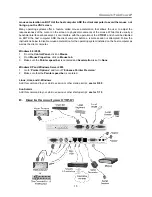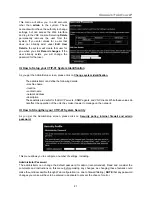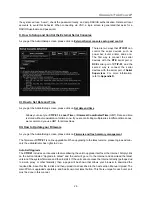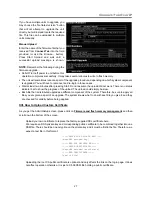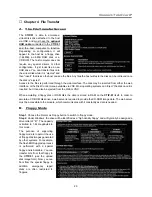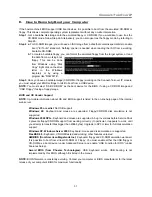
Connect-Tek Over IP
27
If you have multiple units to upgrade, you
may choose the “Get latest version” button
that will not attempt to upgrade the unit
directly, but will instead locate the required
file. This file can be uploaded to multiple
units manually.
Manual Upload
Enter the name of the firmware file that you
received from
Connect-Tek
into the field
provided (or use the Browse... button).
Press Start Upload and wait until a
successful upload message is shown.
NOTE
: Remember the following during the
firmware upgrade…
•
Do NOT turn off power to unit before this
operation completes successfully. It may take several minutes to write to flash memory.
•
The unit will sometimes reboot as part of the upgrade procedure, depending on which system component
is upgraded. You will have to reconnect and re-login in those cases.
•
Wait at least two minutes after pressing Start. Do not assume the upload did not work. There is no status
indicator bar to show the progress of the upload. The upload could simply be slow.
•
Each file that is distributed upgrades a different component of the system. Therefore, be sure to apply all
files you are given as part of an upgrade. The system knows what to do with each file you give it, and they
are checked for validity before being applied.
XIII. How to Upload Custom Certificate
As you get the Admin/Setup screen, please click on
Firmware and flash memory management
, and then
scroll down the bottom of the screen.
Upload your own certificate to replace the factory-supplied SSL certificate here.
We require an RSA private key and corresponding public certificate to be combined together into one
PEM file. There should be no encryption on the private key and it must be first in the file. Therefore, we
expect a text file in this format:
-----BEGIN RSA PRIVATE KEY-----
[based64 encoded key]
-----END RSA PRIVATE KEY-----
-----BEGIN CERTIFICATE-----
[based64 encoded certificate]
-----END CERTIFICATE-----
[end of file]
Uploading the root CA public certificate is optional and only affects the link on the login page. It does
not affect operation otherwise. It is just a X.509 PEM file holding a public certificate.



